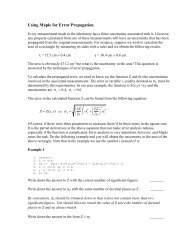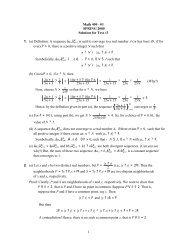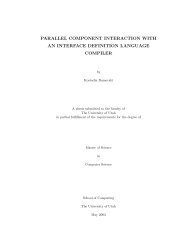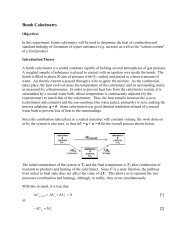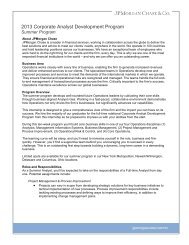Create successful ePaper yourself
Turn your PDF publications into a flip-book with our unique Google optimized e-Paper software.
<strong>The</strong> <strong>Kinetic</strong> <strong>The</strong>ory <strong>of</strong> <strong>Gases</strong><br />
A Maple Exercise<br />
<strong>The</strong> kinetic theory <strong>of</strong> gases is one <strong>of</strong> the cornerstones <strong>of</strong> physical chemistry. It provides a model that<br />
allows the calculation <strong>of</strong> many dynamic properties <strong>of</strong> a perfect gas. Knowledge <strong>of</strong> molecular speeds and<br />
their distribution functions is useful in understanding the rates <strong>of</strong> gas phase reactions.<br />
<strong>The</strong>ory<br />
<strong>The</strong> kinetic theory <strong>of</strong> gases was developed from a model that incorporated the following features:<br />
a) the gas consists <strong>of</strong> large numbers <strong>of</strong> particles in continual random motion,<br />
b) the size <strong>of</strong> the particles is negligible in comparison to the average distance traveled between<br />
collisions, and<br />
c) the particles exert no intermolecular forces on one another and thus their collisions are perfectly<br />
elastic.<br />
<strong>The</strong> predictions <strong>of</strong> the kinetic theory are found to agree well with the actual behavior <strong>of</strong> real gases at<br />
normal pressures and temperatures well above their boiling points.<br />
According to the kinetic theory, the temperature <strong>of</strong> a gas is a measure <strong>of</strong> the average translational kinetic<br />
energy <strong>of</strong> the gas, and is thus also a measure <strong>of</strong> the average speed, , <strong>of</strong> the gas particles. Common<br />
sense (and experimental results) tells us that not all gas particles move with the average speed -- some<br />
move faster than average and some slower. A distribution function provides the fraction <strong>of</strong> molecules<br />
with speeds between c and c + dc. <strong>The</strong> distribution function for perfect gases is called the Maxwell-<br />
Boltzmann distribution function and is given below:<br />
⎛ m ⎞<br />
3/2c F(c) dc = 4π ⎜ ⎟<br />
2<br />
⎝ 2πkT⎠<br />
exp ⎛<br />
− ⎞<br />
⎜<br />
mc2<br />
⎟ dc [1]<br />
⎝ 2kT ⎠<br />
where m is the molecular mass, k is the Boltzmann constant, and T is the Kelvin temperature. Note<br />
especially the dependence <strong>of</strong> this function on mass and temperature. This equation can be plotted as a<br />
function <strong>of</strong> c to see how the fraction <strong>of</strong> molecules with a given speed changes with speed or<br />
temperature. <strong>The</strong> above equation can also be used for several purposes. <strong>The</strong> maximum <strong>of</strong> the<br />
distribution function provides the most probable speed, c * . Differentiating Equation [1] with respect to<br />
c and solving for c when the derivative equals zero one obtains the most probable speed.<br />
⎛<br />
c* = 2kT ⎞<br />
⎜ ⎟<br />
⎝ m ⎠<br />
1/ 2<br />
[2]<br />
<strong>The</strong> fraction <strong>of</strong> particles with speeds between c 1 and c 2 can be obtained by integrating equation [1]<br />
between c 1 and c 2 .<br />
One <strong>of</strong> the most powerful uses <strong>of</strong> distribution functions is calculating averages. For any distribution<br />
function F(x), the average <strong>of</strong> any property which depends on x (such as ξ) is given by<br />
ξ = ∫ ξ F(x) dx [3]<br />
Using this, the average speed can be determined by evaluating
c = ∫ c F(c) dc [4]<br />
where the limits <strong>of</strong> integration range from c=0 to c=∞. <strong>The</strong> resulting integral is<br />
⎛<br />
c =<br />
8kT ⎞<br />
⎜ ⎟<br />
⎝ πm ⎠<br />
1/2<br />
[5]<br />
In a similar manner, the root-mean-square speed, c rms , is determined by evaluating<br />
c 2 1/2 ≡ c rms<br />
= ( ∫c 2 F(c)dc) 1/ 2 [6]<br />
<strong>The</strong> integral evaluates to the following simple expression.<br />
c rms<br />
= ⎜<br />
⎛<br />
⎝<br />
3kT<br />
m<br />
⎞<br />
⎟<br />
⎠<br />
1/ 2<br />
[7]<br />
<strong>The</strong> root-mean-square speed is particularly useful since the average translational kinetic energy E K is<br />
given by<br />
E K<br />
= 1 2 mc 2<br />
= 1 2<br />
2 mc rms<br />
[8]<br />
Combining equations [7] and [8] yields<br />
E K<br />
= 3 2 kT [9]<br />
the average translational energy per particle for a perfect gas. This result agrees well with experimental<br />
values for monatomic gases. Note that the average kinetic energy is not a function <strong>of</strong> the mass <strong>of</strong> the<br />
particles involved.<br />
<strong>The</strong> kinetic theory also provides information regarding molecular collisions. <strong>The</strong> number <strong>of</strong> collisions<br />
experienced by a single particle per second per unit volume is given by<br />
z A<br />
= 2πd 2 c N<br />
V<br />
= 2πd 2 c p<br />
kT<br />
[10]<br />
where d is the molecular diameter and N the number <strong>of</strong> particles per volume V. <strong>The</strong> quantity π d 2 is<br />
<strong>of</strong>ten called the collision cross section and is given the symbol σ. <strong>The</strong> total number <strong>of</strong> collisions<br />
between particles per second per unit volume is given by<br />
Z AA<br />
= πd 2 c N 2<br />
2<br />
[11]<br />
Calculations<br />
1. Determine the Maxwell-Boltzmann distribution function for hydrogen gas and oxygen gas at 298 K<br />
(plot data for both on same graph). Remember, these gases are diatomic and check you units!<br />
2. Determine the Maxwell-Boltzmann distribution function for oxygen at 298 K and 500 K (plot data<br />
for both on same graph)
3. Determine the most probable speed for oxygen at 298 K and 500 K.<br />
4. Using your value for the most probable speed at 298 K for oxygen determined in part 3, determine<br />
the fraction <strong>of</strong> molecules at 298 K and at 500 K which have speeds greater than this speed.<br />
Assuming this is the minimum speed required for molecules to be travelling in order to react in<br />
some specific reaction, estimate the relative reaction rates at the two temperatures. Make sure you<br />
use the same speed for both curves.



